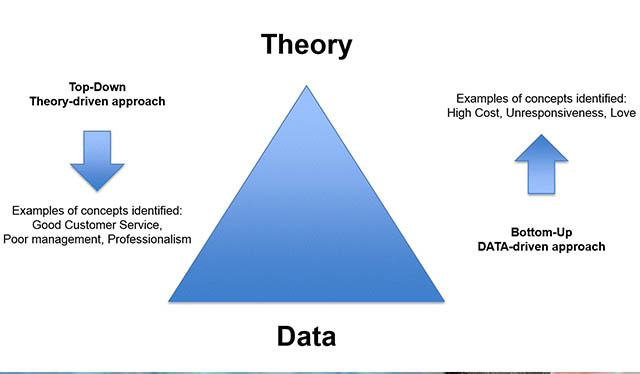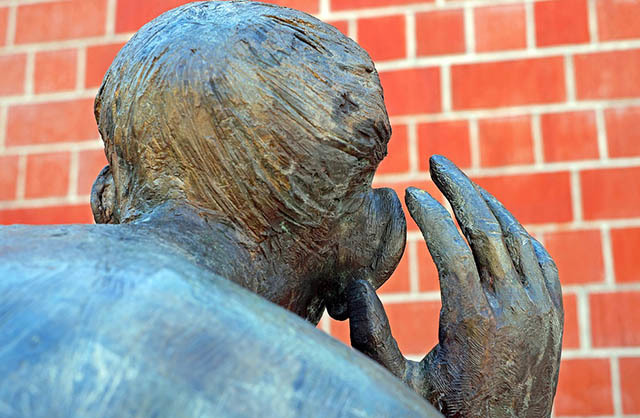Is Top Down or Bottom Up Processing Best When Learning Chinese?

You might have heard of top down or bottom up language learning techniques. If not, don’t worry, by the time you finish this article you’ll know what they are and the advantages and disadvantages of using them. You’ll also know in what ways to use them to help you boost your Mandarin Chinese proficiency in no time.
 Thanks to odintext.com
Thanks to odintext.com
What’s the Difference Between the Top Down And Bottom Up Approach?
Imagine the language you’re learning as a kind of pyramid. At the bottom the bricks represent words and letters, up a little bit and you start to see phrases form. Further up the pyramid, you start to see more complex phrases and smaller sentences, and then finally at the top you see a fully constructed and accurate complex sentence.
Essentially, you’re looking at a graduation of difficulty, from easy to hard. Surely any learner would start at the bottom though, right? When it comes to top down or bottom up processing, bottom up must be where you need to start. After all, words and vocabulary are the easiest to learn and are an integral stepping stone to being able to master a language. Without the foundations, how can you construct anything?
Well, when you’re learning a language you actually use both to some degree. Whilst some educators believe that this depends on the level of the learner, the skill you are using can actually be more important. Going from the bottom of the pyramid (bottom up) or starting from the top (top down), both work better when it comes to different skill sets.
 Do you think speaking is a predominantly top down or bottom up process?
Do you think speaking is a predominantly top down or bottom up process?
Speaking
Speaking comes from inside you. Unless your reading off a piece of paper (and that’s not speaking, it’s reading), you should be coming up with words and sentences on the fly. This doesn’t come from nowhere. Unless you have the building blocks which come with bottom up processing, you’re not going to be able to string much more than a couple of possibly 你好’s together.
When it comes to speaking, a bottom up approach is almost always the best starting point. Begin by working on basic vocabulary acquisition, then start to move onto stringing that vocab together.
Once you’ve put in enough time on this, you can then start to use the other skills listed below to start building up your vocabulary and content with a top down approach.
 That ink blotch is not part of the bottom up process.
That ink blotch is not part of the bottom up process.
Writing
Writing and speaking are practically two peas in a pod when it comes to top down or bottom up processing. They both have a tendency towards working best with bottom up processing. And just like Gordan Ramsey’s taste tests, writing is going to involve a good deal of awkward experiences to start off with. Listening on the other hand...
 Bottom up: It doesn't mean you have to start physically at the bottom, just with the simplest things.
Bottom up: It doesn't mean you have to start physically at the bottom, just with the simplest things.
Listening
Listening is basically the opposite of speaking, right? So do you think it’s top down or bottom up?
Well, in some ways it is bottom up because we are taking the smaller elements and combining them to create meaning. However, when we learn a second language and start to listen to more complex sentences, we start to find words or phrases which we don't understand.
So whilst in some ways listening can be a bottom up processing example as you are building meaning, it can also be a top down processing example. Especially when you are taking content from somewhere else and can't fully understand it. You then have to rely on other bits of information, combined with what you understand, to create meaning.
For instance, when [you're in a loud place](you're in a loud place) and your friends are talking to you, but you can only understand a little of what they say. Instead of getting angry and running off in a huff because you don't understand what they're saying, you would likely use top down processing to piece it all together.
Take the sentence:
我喜欢吃鱼但是我只吃我喜欢的风味。
Wǒ xǐhuān chī yú dànshì wǒ zhǐ chī wǒ xǐhuān de fēngwèi.
I like eating fish, but only when it’s cooked just right.
Imagine that I just said this sentence to you and this was the first time you had heard it. How much of it would you be able to piece together? Depending on your level, you would likely be able to take the verbs 喜欢 (xǐhuān, like) and 吃(chī, eat), and the object 鱼 (yú, fish), to understand that the basic meaning of the sentence is about eating fish and liking doing so. As it’s learned fairly early on, you would likely also know and recognize 但是 (dànshì, but). This is all bottom up processing. However, you could then guess that there is a condition to liking the fish. Your guess would be the product of top down processing.
 If Jumbo can do it, so can you.
If Jumbo can do it, so can you.
Reading
Similar to listening, reading in a second language also tends to rely on bottom up processing. Again, the content is generally from another source, and you’re just processing it and piecing things together. However, top down processing is also an important part of reading. Sometimes, you probably even do this when you’re using your first language.
Have you ever read a complicated book and found a word which you don’t know the meaning of? Some of us might go and find a dictionary and look it up. Others, however, would just use their top down processing to guess that meaning of that word based on what surrounds it. We would take clues from the larger context.
Similarly, when we are reading a story, we tend to try and guess what will happen in the future. this is top down processing at its finest, and a great activity to engage in when learning a second language.

The best language learners make sure to use both techniques. With Mandarin Chinese, it should be less about which is better and more about which is better for a particular situation. There are, after all, advantages to both climbing up a mountain, and descending one, but they can both be difficult in the end.
